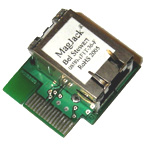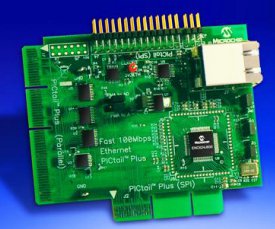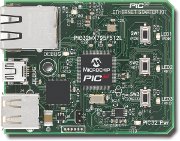Getting Started: Running the “Google Map” demo
Required Hardware
Configuring the Software
Configuring the Hardware
Calibrating the Touch Screen
Demo Compatibility Matrix
Running the Demo:
This is the implementation of the basic Google Maps™ functionality in a PIC device. The user can enter an address or select from a pre-selected addresses to display a static map. For details on how static maps are handles refer to: http://code.google.com/apis/maps/documentation/staticmaps/ for details.
The demo has a main menu where the user can zoom in or zoom out (using the +, - buttons or the slider) of the displayed map. User can select the view mode and enter new or predefined address using the four buttons:
1. MAP – selects the map view
2. SATELLITE – selects the satellite view
3. TERRAIN– selects the terrain view
4. ADDR – enters the address selection menu. This menu allows the user to enter a new address using the qwerty keyboard on the screen or select from the predefined addresses using the PRESET button. As soon as the user hits the DONE button, the map is retrieved and displayed.
This demo does not implement scrolling on the map since scrolling is not implemented in the static map API of Google.
Required Hardware
The demo can only be run on the following hardware platforms:
|
|
Ethernet Board |
3.2″ QVGA Truly TFT Display Board (AC164127-4) |
4.3″ WQVGA Powertip TFT Display Board (AC164127-6) |
|
PIC24FJ256DA210 Development Board (DM240312) |
Ethernet PICtail Plus Daughter Board (AC164123) |
✓(see note 2) |
✓(see note 2) |
|
PIC24FJ256DA210 Development Board (DM240312) |
Fast 100Mbps Ethernet PICtail Plus Daughter Board (AC164132)
|
✓(see notes 1, 2) |
✓(see notes 1, 2) |
|
Multimedia Expansion Board (DM320005) |
PIC32 Ethernet Starter Kit (DM320004)
|
✓(see note 3) |
✗ |
|
Note: 1. Set Fast 100Mbps Ethernet PICtail Plus Daughter Board jumpers: - JP2 – set to closed (ISENSE) - JP3, JP7, JP8, JP9, JP10, JP11 – don’t care 2. Set PIC24FJ256DA210 Development Board jumpers: - JP8 – closed (PMBE1 must be enabled) - JP9 – set to 1-2 (use Y- signal) - JP10 – set to 1-2 (use X+ signal) - JP11 – set to 2-3 (Enable PMA17 to SRAM, demo requires 512 Kbytes of SRAM) - JP12, JP13, JP14, JP15 – don’t care - JP16 – don’t care (or set to default USART_TX-TX) - JP17 – don’t care (or set to default USART_RX-RX) 3. The Multimedia Expansion Board uses the same display used in the 3.2” QVGA Truly TFT display board (AC164127-4). 4. The demo is not limited to the selected display boards used here. Other display boards can be used with the appropriate hardware profiles. |
|||
|
Legend: |
|||
|
✓ |
Supported out of the box |
☒ |
Hardware compatible, will need firmware modification |
|
☑ |
Supported, see limitations |
✗ |
Not supported, hardware not compatible |
Configuring the Software
The demo can be run using the WQVGA or QVGA display when using the PIC24FJ256DA210 Development Board (DM240312) or the Multimedia Expansion Board (DM320005). This is set in the project HardwareProfile.h file by adding the corresponding Graphics hardware profile.
· For QVGA display use:
#include "Configs/HWP_DA210_BRD_16PMP_QVGAv1.h”
· For WQVGA display use:
#include "Configs/HWP_DA210_BRD_16PMP_WQVGAv1.h”
· For the Multi-Media Expansion Board use:
#include "Configs/HWP_MEB_PIC32_ETH_SK_16PMP.h"
The hardware profile file name refers to the combination of Development Boards that are used to run the demo. Refer to the abbreviations summary (link) for details.
Configuring the Hardware
Running the demo on different supported boards will require additional settings on the hardware.
1. PIC24FJ256DA210 Development Board (DM240312) + Fast 100Mbps Ethernet PICtail Plus Daughter Board (AC164132)
a. Set the jumpers on both boards. Refer to the notes section of the table above.
b. Connect the PICtail Board (J2) to the PICtail Plus (J8) connector of the development board with the pin1 of both boards aligned (tip: look for the triangle on both boards and align them).
c. Connect the ethernet cable to the RJ45 ethernet jack of the Fast 100 Mbps Ethernet PICtail Plus Daughter Board.
2. PIC24FJ256DA210 Development Board (DM240312) + Ethernet PICtail Plus Daughter Board (AC164123)
a. Set the jumpers on the development board. Refer to the notes section of the table above.
b. Connect the PICtail Board to the PICtail Plus (J8) connector of the development board with the pins(1-30) of the development board connected to the PICtail Plus board.
c. Connect the ethernet cable to the RJ45 ethernet jack of the Ethernet PICtail Plus Daughter Board.
3. PIC32 Ethernet Starter Kit (DM320004) on the Multimedia Expansion Board (DM320005) – There are no special settings when using this boards. Refer to Configuring the Hardware (Configuration 3: Multimedia Expansion Board) for details on how to set up the hardware. Just connect the Ethernet cable to the RJ45 Ethernet jack of the PIC32 Ethernet Starter Kit.
Refer to Configuring the Hardware (Configuration 1: PIC24FJ256DA210 Development Board) for details of the default settings of the board.
The Microchip name and logo, the Microchip logo, MPLAB, and PIC are registered trademarks of Microchip Technology Incorporated in the U.S.A. and other countries.
PICDEM and PICTail are trademarks of Microchip Technology Incorporated in the U.S.A. and other countries.
SD is a trademark of the SD Association in the U.S.A and other countries
Microsoft, Windows, Excel, and Windows Vista are either registered trademarks or trademarks of Microsoft Corporation in the United States and/or other countries.


